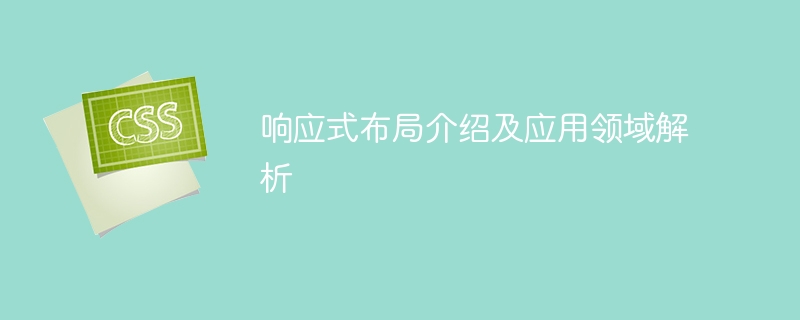

Introduction to responsive layout and analysis of application areas
With the popularity and diversification of mobile devices, users have an increasing need to access web pages on screens of different sizes. In order to adapt to the needs of different screen sizes, responsive layout came into being. In this article, we will introduce what responsive layout is and its use in application areas.
Responsive layout is a web design method that can adjust the layout and element size of the web page according to the screen size and resolution of the access device, thereby providing users with a better browsing experience. Traditional fixed layout designs can only adapt to specific screen sizes, while responsive layouts can adapt to any screen size, whether it's a large desktop or a small mobile phone.
The core idea of responsive layout is to use fluid grid and media queries. Fluid grid is a way to make web page layout adapt to different screen sizes by defining the width and height of elements as percentages. This way, no matter how the screen size changes, the relative size of the elements will adjust accordingly. Media query is a CSS3 function that can customize style settings for different screen sizes based on different media types and specific CSS properties. Through media queries, we can define layout styles and element sizes under different screen sizes to achieve responsive layout.
The application fields of responsive layout are very wide. First, its application on mobile devices is very important. With the popularity of smartphones and tablets, more and more users access the web through mobile devices. If the web page cannot adapt to different screen sizes, users will not be able to browse and use the web page normally. With responsive layout, web pages can automatically adjust the layout and element size according to the user's device, thereby providing a good mobile browsing experience.
Secondly, responsive layout is also very important in the field of e-commerce. With the popularity of mobile shopping, more and more users are shopping on their mobile phones. If an e-commerce website cannot adapt to the screen size of mobile devices, users will not be able to browse and purchase items conveniently. Through responsive layout, e-commerce websites can provide a unified shopping experience on various devices, thereby improving users' shopping experience and purchase conversion rate.
In addition to mobile devices and e-commerce, responsive layout can also be applied in other fields. For example, a news website can use responsive layout to provide typography and layout suitable for reading on different screen sizes. Educational institutions can use responsive layout to allow students to easily browse course content on different devices. Enterprises can provide enterprise information and services suitable for various devices through responsive layout.
To sum up, responsive layout is a design method that can automatically adjust the layout and element size of web pages according to the screen size. It's implemented through fluid grids and media queries to adapt to a variety of screen sizes and device types. Responsive layout is particularly important in mobile devices and e-commerce, and can be applied in other areas. With responsive layout, we can provide users with a better browsing experience, even on screens of different sizes.
The above is the detailed content of Analysis of responsive design principles and discussion of application scenarios. For more information, please follow other related articles on the PHP Chinese website!
 The difference between Fahrenheit and Celsius
The difference between Fahrenheit and Celsius
 The role of float() function in python
The role of float() function in python
 Configure Java runtime environment
Configure Java runtime environment
 What to do if the documents folder pops up when the computer is turned on
What to do if the documents folder pops up when the computer is turned on
 The role of registering a cloud server
The role of registering a cloud server
 How to buy Ripple in China
How to buy Ripple in China
 NTSD command usage
NTSD command usage
 phpstudy database cannot start solution
phpstudy database cannot start solution
 Usage of background-image
Usage of background-image